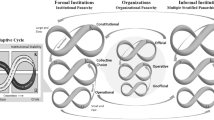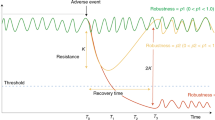Abstract
Environmental sciences have an important role in informing sustainable management of built environments by providing insights about the drivers and potentially negative impacts of global environmental change. Here, we discuss panarchy theory, a multi-scale hierarchical concept that accounts for the dynamism of complex socio-ecological systems, especially for those systems with strong cross-scale feedbacks. The idea of panarchy underlies much of system resilience, focusing on how systems respond to known and unknown threats. Panarchy theory can provide a framework for qualitative and quantitative research and application in the environmental sciences, which can in turn inform the ongoing efforts in socio-technical resilience thinking and adaptive and transformative approaches to management.
Similar content being viewed by others
Society currently faces a range of challenges that derive from swiftly changing environmental and social baselines, including an increased probability of rapid and unforeseen loss of natural capital, loss of biodiversity and risks to public health. The extent of human influence over global systems has resulted in challenges for which the scale and complexity are generally unprecedented. The complex interdependencies of environmental problems, for example those deriving from climate change, transcend local (e.g., methane emission from a lake) to regional (hurricanes) to global (sea level rise) scales and result in a “wicked problem” that seriously challenges our ability to sustain human welfare and healthy ecosystems (Rittel and Webber 1973). Inherent to contemporary wicked problems are at least four fundamental characteristics: (1) socio-ecological system interdependencies (e.g., relationship between fisheries, ecosystem service provisioning, resource overexploitation and aquatic resource degradation), (2) temporal and spatial cross-scale interdependence of impacts (e.g., relationship between global warming and methane emission from a lake), (3) dynamic and nonlinear changes including regime shifts (e.g., shift from a clear-water lake to a turbid lake, or coral-dominated to algal-dominated reefs) and (4) high uncertainty of environmental change outcomes (e.g., complex and multi-dimensional interactions between biophysical factors limiting prediction of change). Environmental science has an important role to play in contributing to human understanding the dynamics, drivers and solutions of wicked problems. Coping with and managing the challenges at hand requires integrative models that account for this complexity and complement traditional approaches for dealing with change and its associated risks.
Panarchy, a theory pioneered by Gunderson and Holling (2002) to account for the complex dynamics of systems of people and nature, can provide quantitative and qualitative underpinning for risk management and vulnerability and risk assessments. It aims to capture the structures envisioned in hierarchy theory (Allen and Starr 1982), as well as acknowledge top-down and bottom-up processes that account for many observed dynamics in nature (Fig. 1). Panarchy theory encompasses complex system dynamics such as adaptation, conservatism, collapse and reorganization (Fig. 1) that are intrinsic to environmental change and critically linked to important and interconnected phenomena such as novelty, innovation and regime shifts in complex systems (Allen et al. 2014). The theory can provide a heuristic to conceptualize different aspects of system organization (Allen et al. 2014) or can be formulated into hypotheses for individual premises and empirically tested (Angeler et al. 2015).
Diagram of a panarchy showing complex system dynamics such as adaptation, conservatism, collapse and reorganization (adaptive cycles), and their relationship between spatiotemporal scales. Three scales of pattern–process relationships (for convenience only) and their cross-scale interactions from lower to higher levels and vice versa in the panarchy are shown
A panarchy can be regarded as a nested set of adaptive cycles (Gunderson and Holling 2002), which may be a particularly apt heuristic for framing environmental phenomena that are characterized by complexity and that are inherent in wicked problems. The theory explicitly accounts for discrete spatial and temporal domains at which ecological patterns manifest and processes unfold (Fig. 1). Panarchy theory recognizes both processes that percolate up from lower to higher scales (Fig. 1), such as methane emission in a single lake that contributes to the global carbon balance in the atmosphere, and top-down control, for example, when further atmospheric carbon enrichment boosts local emission of methane from lakes. In the above climate context, adaptive cycling is manifested in carbon emissions that vary seasonally in a lake, as well as large-scale weather patterns that vary inter-annually due to warming associated with atmospheric carbon increase (e.g., North Atlantic Oscillation or El Niño Southern Oscillation). These dynamic patterns are linked across scales (from local, to regional, to global), making patterns at one scale dependent on those at other scales.
There is increasing recognition that from wicked problems emerges a myriad of new and uncharacterized risks. Resilience thinking, which focuses on the ability of systems to prepare for, absorb and recover from an adverse event and crucially adapt to new conditions (Linkov et al. 2014; Larkin et al. 2015), offers a new way of living with these risks. In panarchy theory, resilience is a primary variable that controls the adaptive cycling of nested systems, where resilience is measured by the magnitude of disturbance that can be absorbed before the system changes its structure, functions and feedbacks (Holling 1973). The interconnectedness of hierarchical scales in a panarchy contributes to system resilience because disturbances at one scale can be absorbed by other scales in the system (Nash et al. 2014). That is, panarchy theory accounts for feedbacks that can stabilize or destabilize system configurations due to cross-scale interactions. Imagine a severe winter in which lakes in a region are solidly frozen, inhibiting the emission of carbon to the atmosphere. The concentration of carbon in the atmosphere will be marginally affected. Carbon-enriched conditions in the atmosphere will be maintained and patterns of global warming will not be disrupted, affecting ecological structures and functions across scales (local extinctions of cold-adapted species; regionally and globally changing species distribution patterns) and ultimately environmental sustainability.
There have been diverse and successful applications of panarchy in ecological (Angeler et al. 2016) and social analyses (Berkes and Ross 2016; DeWitte et al. 2016; Green et al. 2015). Because the interplay of systems has implications for how we manage for resilience, it is important that these analyses be extended to physical and environmental mathematical models in the engineering sciences. Whereas natural and social systems have the capacity to self-organize, engineered systems require human intervention to adapt to changing conditions (Schultz et al. 2012) and therefore require a flow of information about how the dynamics of the larger system is changing.
Panarchy theory can provide a framework for qualitative and quantitative research and application in the environmental sciences, which can in turn inform the ongoing efforts in socio-technical resilience thinking (Linkov et al. 2013) and adaptive and transformative approaches to management (Allen and Garmestani 2015; Chaffin et al. 2016). However, research is needed to facilitate the application of panarchy to environmental science; data limitations and insufficient information regarding mechanisms, critical processes and feedbacks for many systems currently limit its broader implementation. To ensure efficient use of limited resources necessary for implementation of panarchy theory and to address crucial data gaps, we suggest:
-
1.
Using quantitative decision analytical tools to focus modeling and monitoring on important environmental management needs and scientific gaps;
-
2.
Increasing monitoring efforts for identifying key variables in systems under study to assess patterns, processes and feedbacks within and across scales;
-
3.
Targeting mechanisms associated with change using replicated field experiments. Such experiments can be designed to manipulate intrinsic and/or extrinsic controlling factors (akin to pressures deriving from multiple stressors in current environmental change scenarios), for assessing how manifestations of panarchy theory (adaptation, conservatism, collapse, reorganization) vary.
In these and potentially other areas of information need, tools and methods from systems science, systems analysis, systems engineering, regime theory, dynamic similarity, classical dynamics, chaos theory and discrete event simulation could be used for studying environmental change uncertainties applying panarchy theory.
References
Allen CR, Garmestani AS (2015) Adaptive management of social-ecological systems. Springer, New York
Allen TFH, Starr TB (1982) Hierarchy: perspectives for ecological complexity. University of Chicago Press, Chicago
Allen CR, Angeler DG, Garmestani AS, Gunderson LH, Holling CS (2014) Panarchy: theory and applications. Ecosystems 17:578–589
Angeler DG, Allen CR, Garmestani AS, Gunderson LH, Hjerne O, Winder M (2015) Quantifying the adaptive cycle. PLoS One 10:e0146053. doi:10.1371/journal.pone.0146053
Angeler DG, Allen CR, Barichievy C, Eason T, Garmestani AS, Graham NAJ, Granholm D, Gunderson LH, Knutson M, Nash KL, Nelson RJ, Nyström M, Spanbauer TL, Stow CA, Sundstrom SM (2016) Management applications of discontinuity theory. J Appl Ecol 53:688–698
Berkes F, Ross H (2016) Panarchy and community resilience: sustainability science and policy implications. Environ Sci Policy 61:185–193
Chaffin BC, Garmestani AS, Gunderson L, Benson HM, Angeler DG, Arnold CA, Cosens B, Craig RK, Ruhl JB, Allen CR (2016) Transformative environmental governance. Annu Rev Res Environ. http://www.annualreviews.org/doi/abs/10.1146/annurev-environ-110615-085817
DeWitte SN, Kurth MH, Allen CR, Linkov I (2016) Disease epidemics: lessons for resilience in an increasingly connected world. J Publ Health. doi:10.1093/pubmed/fdw044
Green OO, Garmestani AS, Allen CR, Ruhl JB, Arnold CA, Gunderson LH, Graham NAJ, Cosens B, Angeler DG, Chaffin BC, Holling CS (2015) Barriers and bridges to the integration of social-ecological resilience and law. Front Ecol Environ 13:332–337
Gunderson LH, Holling CS (2002) Panarchy: understanding transformations in human and natural systems. Island Press, Washington, DC
Holling CS (1973) Resilience and stability of ecological systems. Annu Rev Ecol Syst 4:1–23
Larkin S, Fox-Lent C, Eisenberg DA, Trump BD, Wallace S, Chadderton C, Linkov I (2015) Benchmarking agency and organizational practices in resilience decision making. Environ Syst Decis 35:185–195
Linkov I, Eisenberg DA, Bates ME, Chang D et al (2013) Measurable resilience for actionable policy. Environ Sci Technol 47:10108–10110
Linkov I, Kröger W, Levermann A, Renn O et al (2014) Changing the resilience paradigm. Nat Clim Change 4:407–409
Nash KL, Allen CR, Angeler DG, Barichievy C, Eason T, Garmestani AS, Graham NAJ, Granholm D, Knutson M, Nelson RJ, Nyström M, Stow CA, Sundstrom SM (2014) Discontinuities, cross-scale patterns and the organization of ecosystems. Ecology 95:654–667
Rittel HWJ, Webber MM (1973) Dilemmas in a general theory of planning. Policy Sci 4:155–169
Schultz MT, McKay SK, Hales LZ (2012) The quantification and evolution of resilience in integrated coastal systems. U.S. Army Corps of Engineers, ERDC TR-12-7. http://el.erdc.usace.army.mil/elpubs/pdf/tr12-7.pdf
Acknowledgments
The views and opinions expressed in this article are those of the individual authors and not those of the US Army, the US EPA and other sponsor organizations. The Nebraska Cooperative Fish and Wildlife Research Unit is jointly supported by a cooperative agreement between the U.S. Geological Survey, the Nebraska Game and Parks Commission, the University of Nebraska-Lincoln, the United States Fish and Wildlife Service and the Wildlife Management Institute. Funding was provided by the August T. Larsson Foundation of the Swedish University of Agricultural Sciences, the Swedish Research Councils FORMAS (2014-1193) and VR (2014-5828) and the United States Department of Defence. Anonymous reviewers and Margaret Kurth provided helpful comments on a previous manuscript version.
Author information
Authors and Affiliations
Corresponding author
Rights and permissions
Open Access This article is distributed under the terms of the Creative Commons Attribution 4.0 International License (http://creativecommons.org/licenses/by/4.0/), which permits unrestricted use, distribution, and reproduction in any medium, provided you give appropriate credit to the original author(s) and the source, provide a link to the Creative Commons license, and indicate if changes were made.
About this article
Cite this article
Angeler, D.G., Allen, C.R., Garmestani, A.S. et al. Panarchy use in environmental science for risk and resilience planning. Environ Syst Decis 36, 225–228 (2016). https://doi.org/10.1007/s10669-016-9605-6
Published:
Issue Date:
DOI: https://doi.org/10.1007/s10669-016-9605-6





